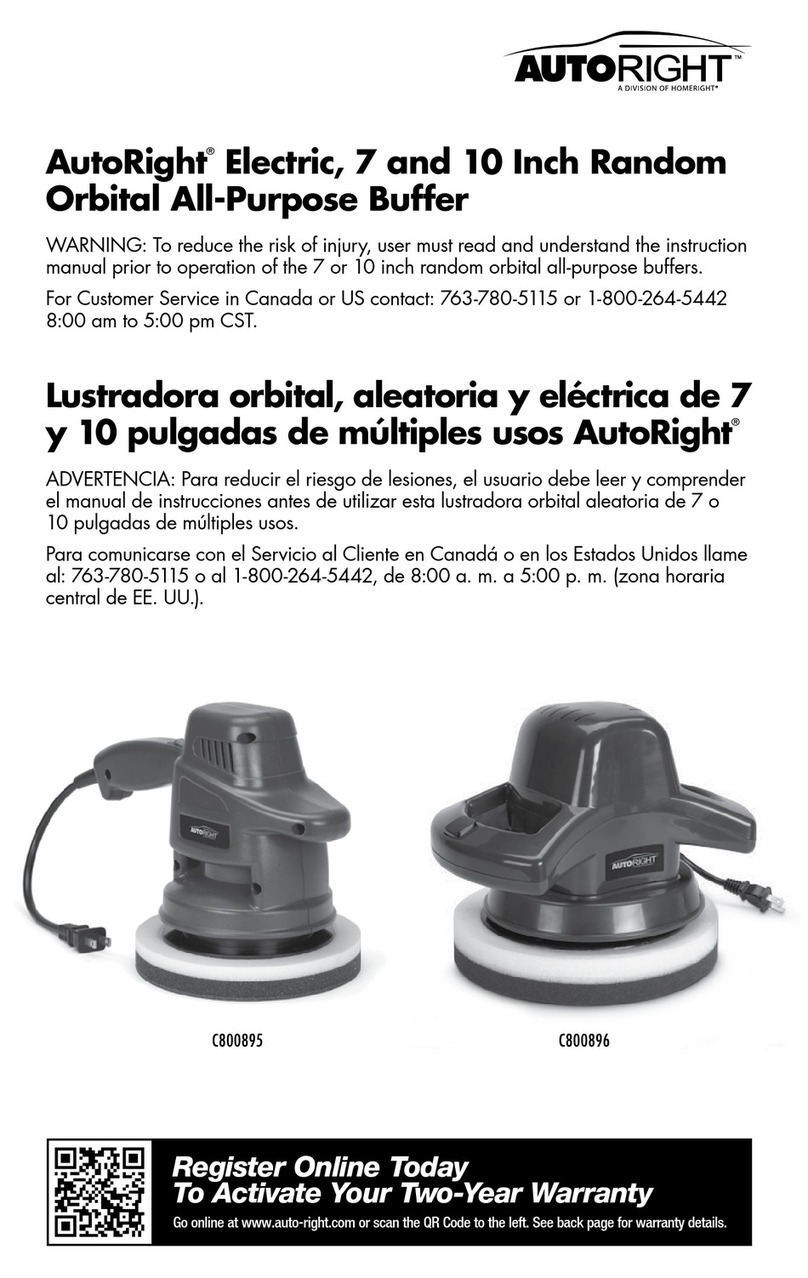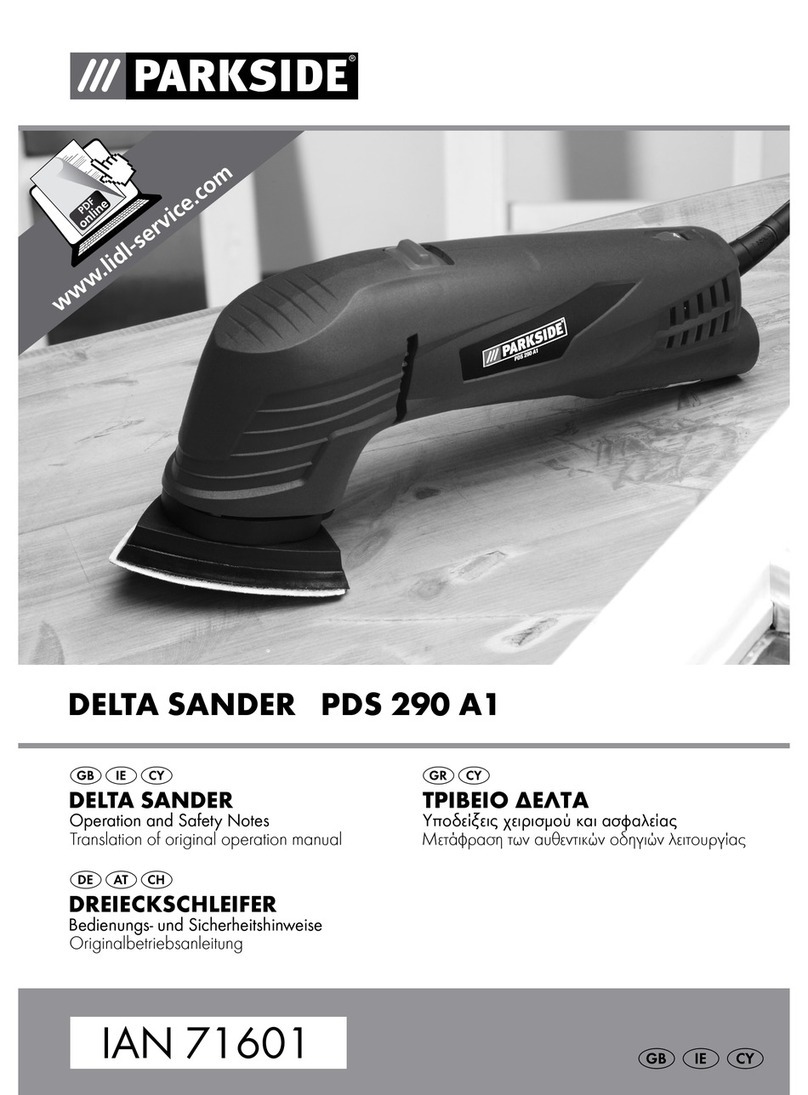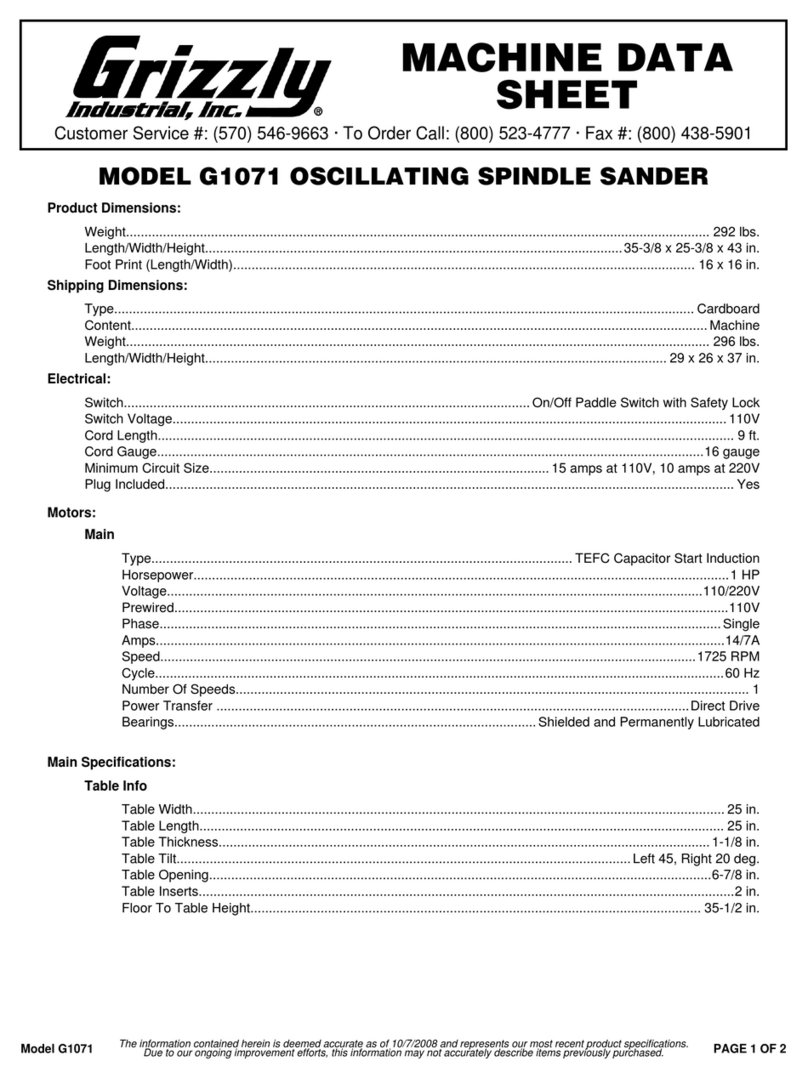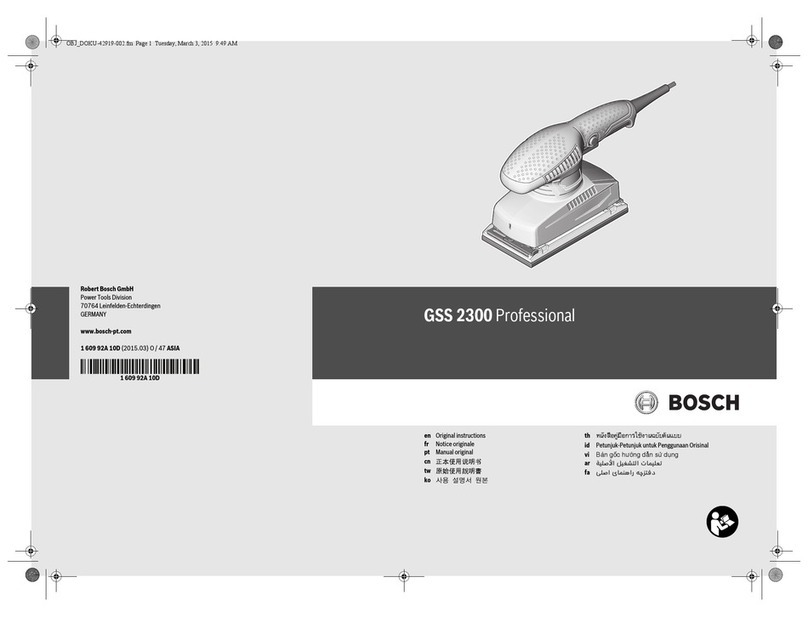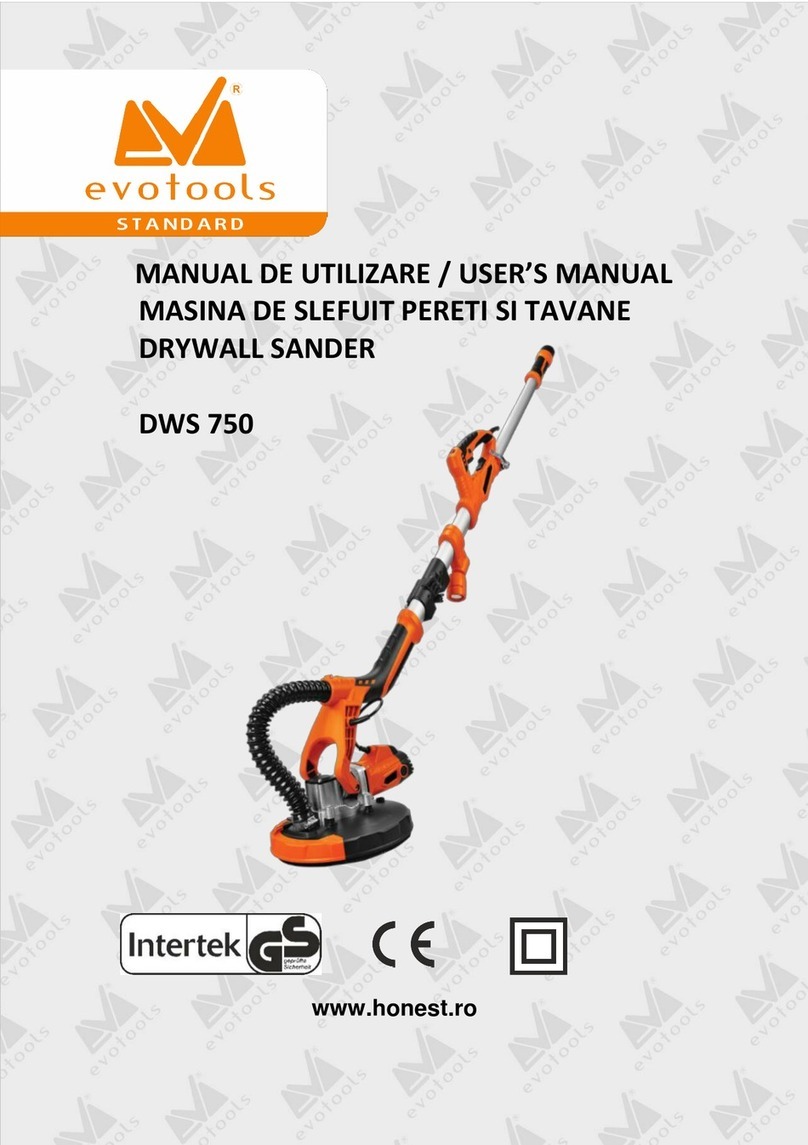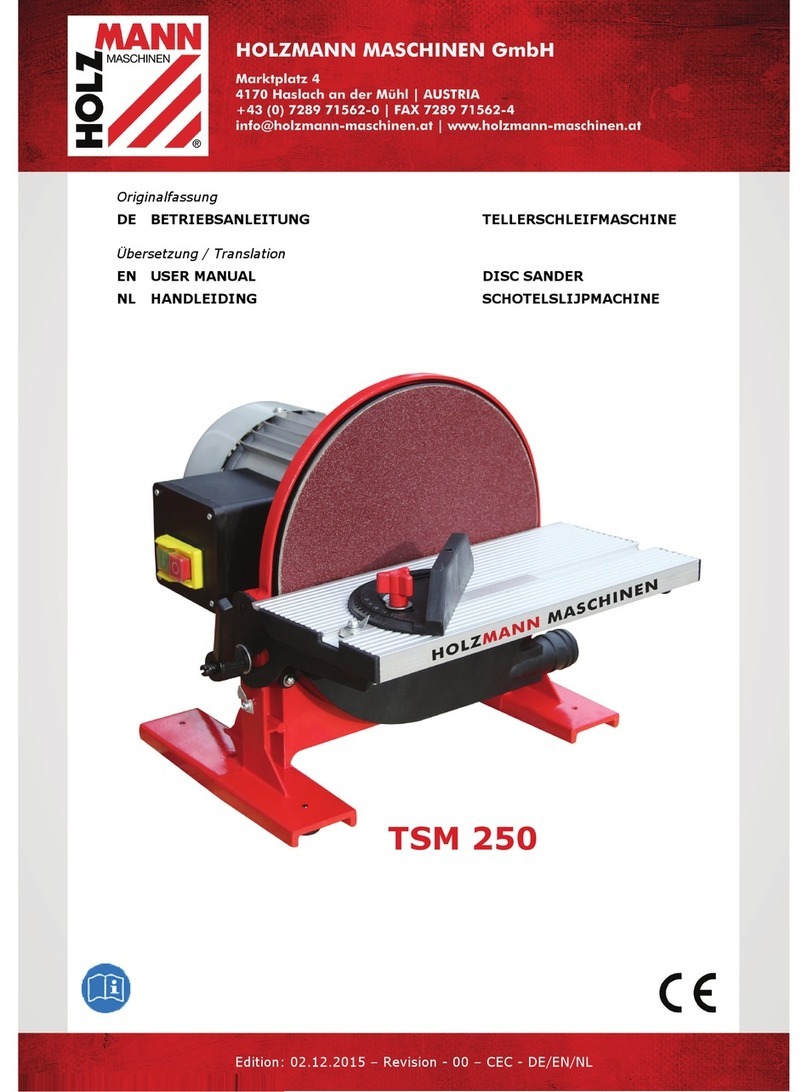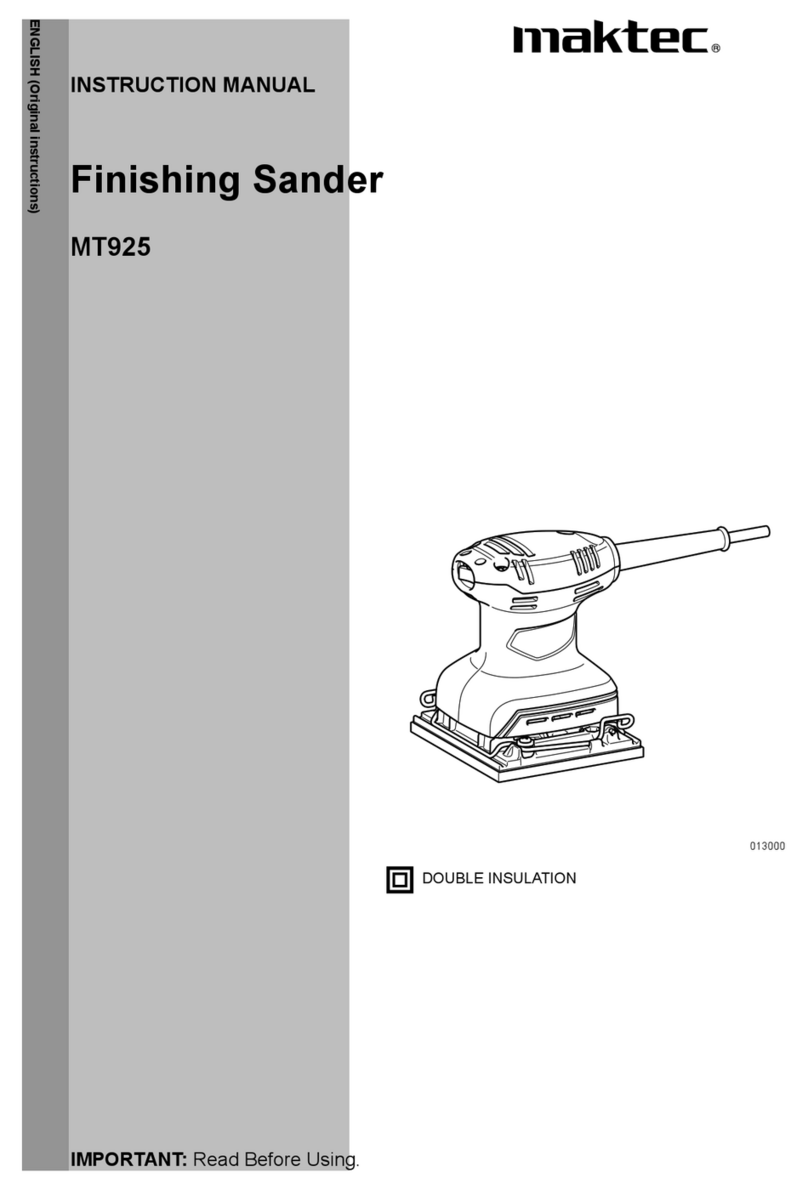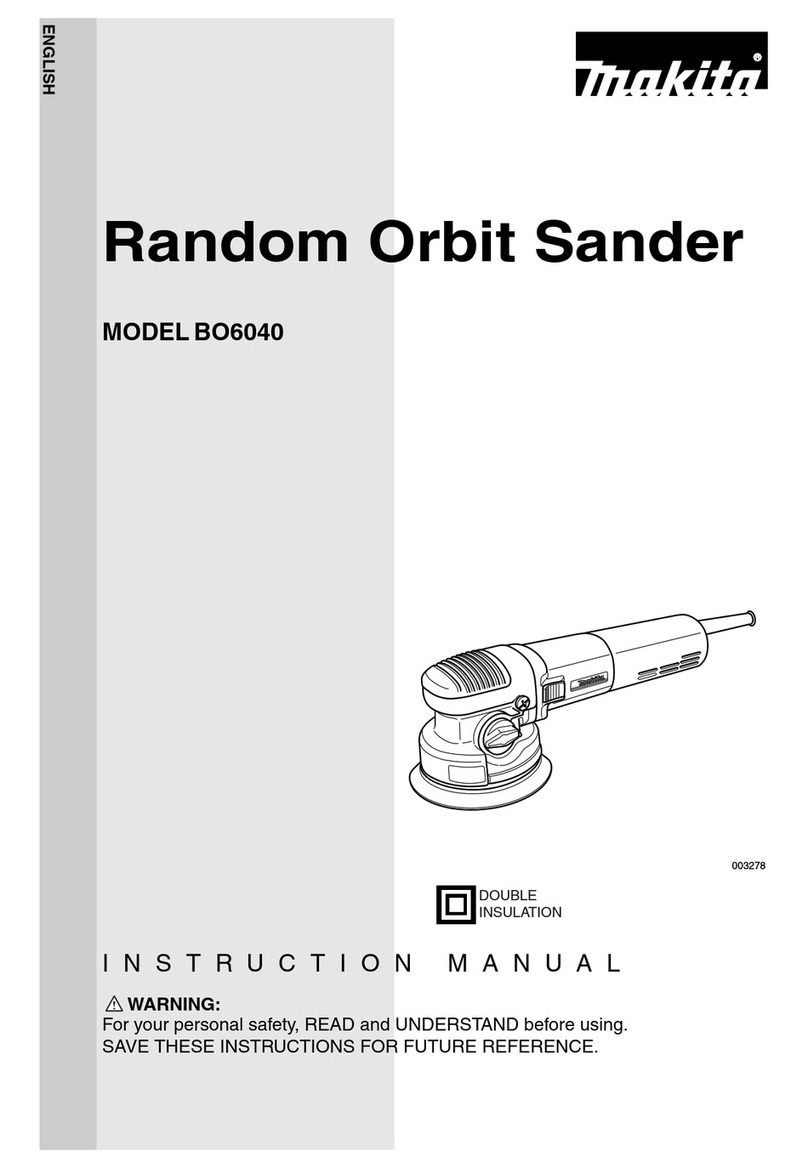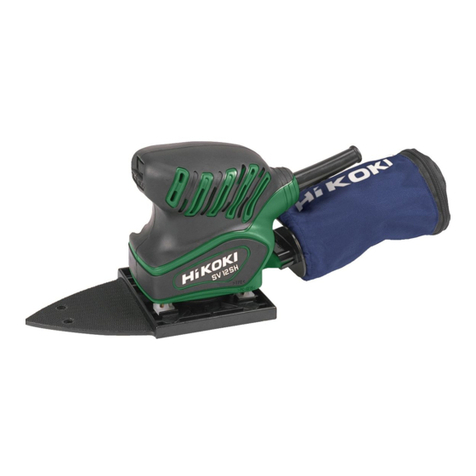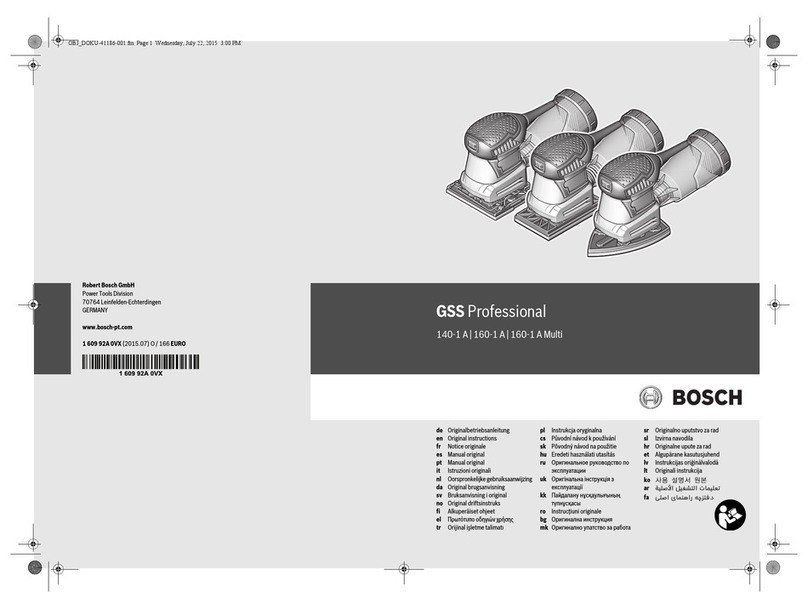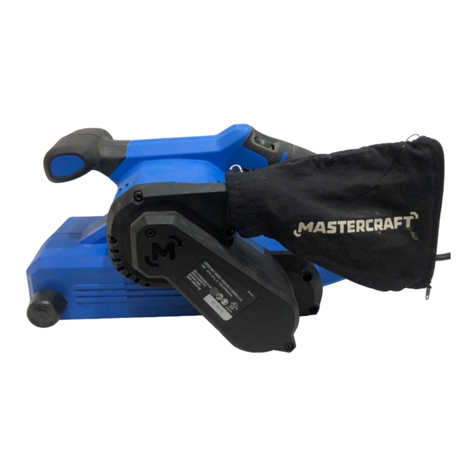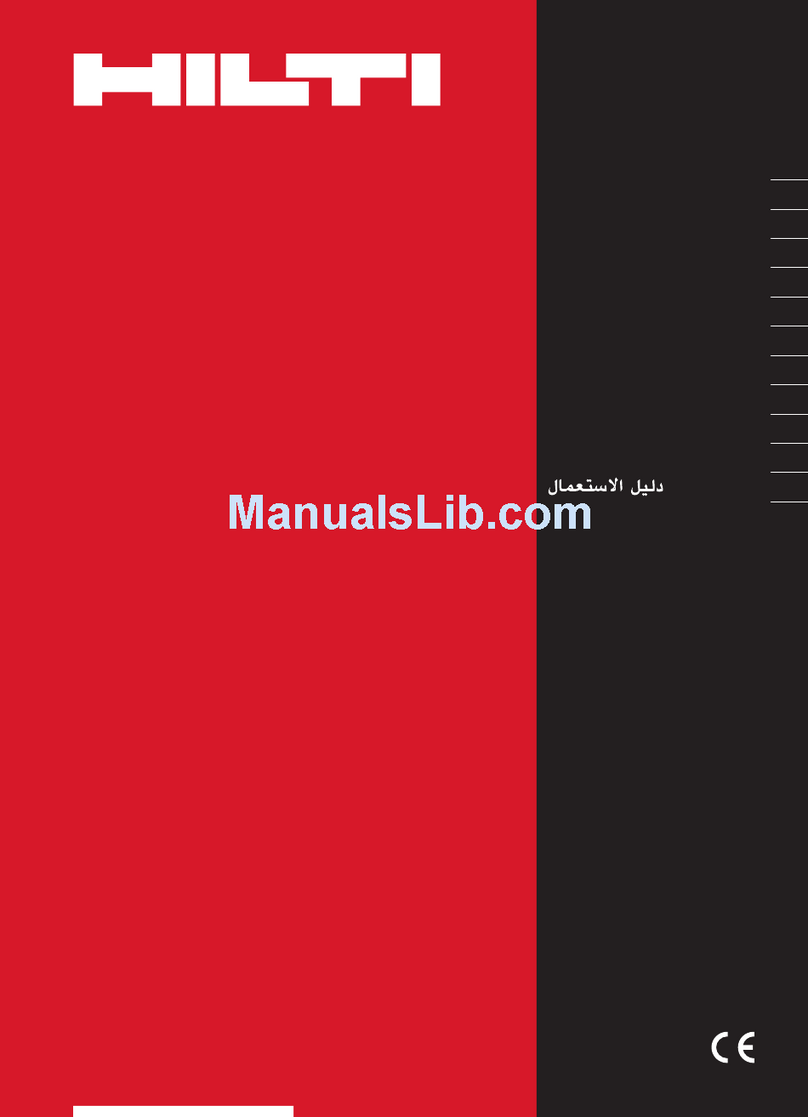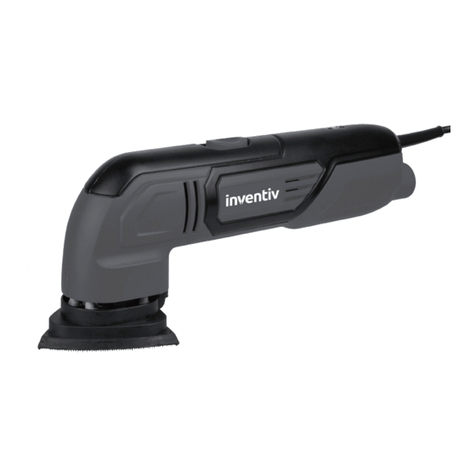autoright 4 inch Cordless User manual

ENGLISH •ESPAÑOL 1
AutoRight®12 Volt, 4 Inch Cordless
Detailing Polisher
WARNING: To reduce the risk of injury, user must read and understand the instruction
manual before prior to operation of this 4 inch orbital polisher.
For Customer Service in Canada or US contact: 763-780-5115 or 1-800-264-5442
8:00 am to 5:00 pm CST.
AutoRight Lustradora/Pulidora
orbital inalámbrica de 10 centímetros
(4pulgadas), a 12 voltios
ADVERTENCIA: Para reducir el riesgo de lesiones, el usuario debe leer y comprender
el manual de instrucciones antes de utilizar esta lustradora/pulidora orbital
inalámbrica de 10 centímetros (4 pulgadas).
Para comunicarse con el Servicio al
Cliente en Canadá o en los Estados
Unidos llame al: 763-780-5115 o al
1-800-264-5442, de 8:00 a. m.
a 5:00 p. m. (zonahoraria central
de EE. UU.).
4 inch cordless • inalámbrica de 10 cm (4 in)

4 INcH cOrdLESS ENGLISH 2
Important Safeguards
General Safety Rules 3
Work Area 3
Personal Safety 3
Tool Use and Care 3
Service 4
Environmentally Safe Disposal of Your
Batteries 4
Battery Safety Rules 4
Batteries and Battery Charger 5
Charging the Battery 5
Specifications of the AC/DC Charger
Adapter 5
Specifications
Kit Contents 6
Parts Listing for the 4 inch Orbital
Polisher/Buffer 6
Operating Instructions
Applications 7
Operation Warnings/Instructions 7
Battery Installation 8
Polishing 8
Clean Up 8
Care of Bonnet and Pad 8
Polisher Maintenance/Storage 8
Car Care Tips 8
Troubleshooting 9
Warranty 17
Medidas preventivas importantes
Normas generales de seguridad 10
Área de trabajo 10
Seguridad personal 10
Uso y cuidado de la herramienta 10
Servicio técnico 11
Cómo eliminar las baterías de
forma segura para el medioam-
biente
11
Normas de seguridad para el
manejo de las baterías 11
Baterías y cargador de baterías 12
Cómo cargar la batería 12
Especificaciones para el adaptador
CA/CC del cargador 12
Especificaciones
Contenido del kit 13
Listado de las piezas de la
lustradora/pulidora orbital de 10
cm (4 in)
13
Instrucciones de funcionamiento
Aplicaciones 14
Advertencias/Instrucciones para el
funcionamiento 14
Instalación de la batería 15
Pulido 15
Limpieza 15
Cuidado del bonete y de la
almohadilla 16
Mantenimiento/Guardado de la
pulidora 16
Consejos para el cuidado del
vehículo 16
Solución de problemas 9
Garantía 17

4 INcH cOrdLESS ENGLISH 3
GENERAL SAFETY RULES
READ AND UNDERSTAND BEFORE USING
!WARNING! Read and understand the user
manual instructions. Failure to follow all
instructions listed below may result in electric
shock, fire and/or serious personal injury.
WORK AREA
1. Keep your work area clean and well lit.
Cluttered benches and dark areas invite
accidents.
2. Do not use power tools in explosive
atmospheres, such as in the presence of
flammable liquids, gases or dust. Power
tools create sparks, which may ignite the
dust and fumes.
3. Keep bystanders, children and visitors
away while operating a power tool.
Distractions can cause you to lose control.
PERSONAL SAFETY
1. Stay alert, watch what you are doing,
and use common sense when operating
a power tool. Do not use tool while tired
or under the influence of drugs, alcohol or
medication. A moment of inattention while
operating power tools may result in serious
personal injury.
2. Dress properly. Do not wear loose clothing
or jewelry. Keep your hair, clothing and
gloves away from moving parts. Loose
clothes, jewelry, or long hair can be caught
in moving parts.
3. Avoid accidental starting. Be sure switch is
in the OFF position before inserting battery
pack. Carrying tools with your finger on
the switch invites accidents.
4. Use safety equipment. Always wear eye
protection. Dust mask, non-skid safety
shoes, hardhat or hearing protection must
be used for appropriate conditions.
TOOL USE AND CARE
1. Prevent Surface Damage: Always use a
clean bonnet with each project. Before
beginning, check bonnet or pad for foreign
elements, dirt and debris. Dirt and debris
can cause damage to the surface of
a vehicle.
2. Use clamps or other practical ways to
secure and support the work piece to a
stable platform. Holding the work by hand
or against your body is unstable and may
lead to loss of control.
3. Do not force tool. Use the correct tool for
your application. The correct tool will do
the job better and safer at the rate for
which it is designed.
4. Do not use tool if switch does not turn on
or off. A tool that cannot be controlled
with the switch is dangerous and must be
repaired.
5. Disconnect battery pack from tool or place
the switch in the locked or off position
before storing to ensure no accidental
starting.
6. Store idle tools out of reach of children
and other untrained persons. Tools are
dangerous in the hand of untrained users.
7. When battery pack is not in use, keep
it away from other metal objects like:
paper clips, coins, keys, nails, screws, or
other small metal objects that can make a
connections from one terminal to another.
Shorting the battery terminals together may
cause sparks, burns or a fire.
8. Check for misalignment or binding of
moving parts, breakage of parts, and
any other conditions that may affect the
tool’s operation. If damaged, have the tool
serviced before using. Many accidents are
caused by poorly maintained tools.
9. Use only accessories that are
recommended by the manufacturer for your
model. Accessories that may be suitable for
one tool may create a risk of injury when
used on another tool.
IMPORTANT SAFEGUARDS

4 INcH cOrdLESS ENGLISH 4
SERVICE
1. Tool service must be performed only by
qualified repair personnel. Service or
maintenance performed by unqualified
personnel may result in a risk of injury.
2. Accessories must be rated for at least the
speed recommended on the tool warning
label. Wheels and other accessories
running over rated speed can fly apart and
cause injury.
Important!: Do not operate the polisher until
you have inspected each part. If any part is
missing or damaged, do not use it. Return
the polisher to the place of purchase. See
WARRANTY.
ENVIRONMENTALLY SAFE DISPOSAL OF
YOUR BATTERIES
!WARNING! If any of your batteries break
or crack, they may or may not leak, do not
attempt to recharge and use it, dispose of it
immediately and replace it with a new one.
Never try to repair a battery. Batteries used
in the tool contain a toxic material called
Cadmium.
!WARNING! Batteries contain toxic
materials and must be disposed in a specific
manners so there is no contamination of the
environment. Before you can dispose of any
worn or damaged batteries, contact your
local Environmental Protection Agency (EPA)
for instructions and information pertaining to
Nickel-Cadmium Batteries.
BATTERY SAFETY RULES
Follow these simple rules to avoid injury and
risk of fire, electrical shock, and explosion.
• Do not attempt to open any battery.
• Do not put the batteries in the regular trash.
• Do not incinerate any battery.
• If a leak appears, the released electrodes
are corrosive, wash your hands and do not
get the material in your eyes or mouth.
• Dispose your batteries to a certied disposal
center.
• When battery pack is not in use, keep it
away from other metal objects such as
paper clips, coins, keys, nails, screws or
other small metal objects that may connect
one terminal. The short of the one terminal
may cause sparks, burn and even a fire.
• The battery pack included with this product
can only be charged by the charger
supplied in this kit, other types may burst
causing fire or other danger.
• Only battery pack supplied in this kit can
be used for the polisher. Other types may
cause fire or other dangers.
• Make sure the switch is in off position
before inserting the battery pack into the
polisher to avoid damages caused by
accidental starting.
• Carrying tools with your nger on the switch
invites accident.
• Ensure battery is disposed of safely as
instructed by the manufacturer.
• Don’t store battery pack in a container with
other metal objects such as nails, coins, etc.
• Don’t short the battery pack; a battery short
can cause a large current flow, overheating,
possible burn and even a fire.
• Don’t expose battery pack to water or rain.
• Don’t carry battery pack in a pocket
containing any metal objects.
• Don’t store the battery pack in locations
where the temperature may reach or
exceed 50°C (182°F).
• Don’t incinerate the battery pack even if
it is severely damaged or is completely
worn out.
• If batteries leak, avoid contact with
the liquid. Should contact occur, wash
immediately with soap and water.
• The polisher should always be off before
inserting or removing the battery pack.
IMPORTANT SAFEGUARDS

4 INcH cOrdLESS ENGLISH 5
BATTERIES AND BATTERY CHARGER
• Unplug your battery charger when you are
not charging your batteries.
• If your battery pack is hot, let it cool before
recharging.
• Do not charge batteries in direct sunlight.
• Keep your battery charger clean, do not
allow materials in the cavity of the charger,
and while UNPLUGGED wipe out the
cavity with a dry cloth, never use water or
solvents.
CHARGING THE BATTERY
Caution: Charge only 12 Volt battery packs
with your charger supplied in this AutoRight
kit, other types may burst causing damage or
personal injury.
• Plug the charger into a 120V AC power
source and insert the battery pack into
the charger receptacle pocket. Make sure
that the polarity rib in the battery pack is
aligned with the polarity slot in the charger.
There are plus and minus symbols on either
side of the battery pack that designate the
polarity of the terminals. These symbols
are on the same sides as their respective
symbols on your charger. In order for the
charger to work properly the pack must be
fully inserted into the charger receptacle
pocket. When fully inserted into the pocket
a light will come on.
• Charge your batteries only with the
HomeRight supplied battery charger.
• Use only (120 volts, 60 HZ AC only) regular
household voltage.
• Don’t charge battery pack when
temperature is below 10°C (50°F) or above
40°C (104°F).
• Don’t attempt to use a step-up transformer,
an engine generator or DC power
receptacle.
• Don’t allow anything to cover or clog the
charger vents.
• Before connecting the charger to a power
source (receptacle or outlet), be certain
the voltage supplied is the same as power
requirements specified on the charger.
Mismatched voltage source can result in
serious injury to the user. When in doubt,
don’t plug in the charger.
• Don’t operate charger if damaged in any
way. Don’t operate charger with damaged
cord. Return product to factory. To prevent
damage to cord when disconnecting
charger from power source, grip plug body
when removing it from a receptacle.
• Unplug charger from outlet before
attempting maintenance or cleaning.
• Don’t substitute charger of any other type.
Doing so may result in risk of electrical
shock, fire or injury to persons.
• Keep charger free of foreign matter.
• Your new battery pack is not fully charged
when received; therefore,charging is
necessary prior to use.
• When not in use the battery pack can be
left on charger (indicated by the red light)
without any adverse effect; the batteries
cannot be “over-charged”. However, if the
battery pack is not going to be used for an
extended period of time the charger should
be unplugged from its power source.
• If you need to charge more than one battery
pack, allow 15 minutes between charges.
SPECIFICATIONS OF THE AC/DC CHARGER
ADAPTER
Output voltage: 15V DC Adapter
Charging time: 5 to 7 hours
IMPORTANT SAFEGUARDS

4 INcH cOrdLESS ENGLISH 6
2
3
6
7
8
10
95
1
4
SPECIFICATIONS
AUTORIGHT ACCESSORIES AVAILABLE:
C800885 Headlight Restoration Kit
C800889 White Scrub Brush
C800882 Foam Applicator Pad
C800883 Poly/Cotton Applicator Pad
C800884 Microfiber Bonnets
C800890 Replacement 12-Volt Battery
SPECIFICATIONS
Orbital Diameter 4”
Rated Voltage 12V
DC Speed Without Load 3300 rpm
Rated Current 5 Amps
Battery (Part Number
C817544) 12V
Battery Type Nickel Cadmium
(Ni CAD)
Rechargable
Charging Time 5 to 7 hours
Charger Input Current 120V AC 60Hz
NOTE: Please contact AutoRight’s customer
service department at 763-780-5115 or
1-800-264-5442. 8:00 am to 5:00 pm CST with
questions.
PARTS LIST
1. Interface Pad
2. Housing
3. Pad Motor Switch
4. 12V Battery
5. Battery Pack Charging Stand
6. AC/DC Charging Adapter
7. Terry Cloth Bonnet
8. Microfiber Bonnet
9. Foam Applicator
10. Scrub Brush

4 INcH cOrdLESS ENGLISH 7
APPLICATIONS
Scrub Brush Poly/Cotton Applicator
Pad
Microfiber Bonnet Foam Pad
Clean/Scrub Polish Buff/Clean Wax Applicator
Vinyl Paint Leather ATVs
Upholstery Plastic Dashboard Motorcycles
Carpet Aluminum Upholstery Boats
Canvas Stainless Paint Snowmobiles
Tires Chrome Glass Detail work on Cars
Outdoor Furniture Glass Bug Shields Wood Furniture
OPERATING INSTRUCTIONS
OPERATION WARNINGS/INSTRUCTIONS
There must be a bonnet on the polishing pad before using the polisher.
Do not press down on the polisher, the machine’s actions, light pressure does the best job.
Do not make adjustments to the polisher while it is in operation.
When the polisher is not in use for a short duration, rest the polisher in an upright position.
• The most common error is applying too much wax.
Before you begin, make sure the work surface is clean and dry. If the work surface is a car,
remove road tar with a general cleaner and remove excess grease spots, bugs, stains, and
other surface problems before waxing or polishing.
• Make sure the work surface is free of objects that could tear the bonnet or damage the pad.
• Make sure a clean bonnet is used at the start of each project. Before beginning check pad for
dirt and debris and remove, if dirt and debris are left on the pad it may cause damage to the
surface.
• Always start and stop polisher on or against the surface of the car.
• If the bonnet should come off the pad, you may be using too much wax.
• Do not wax a surface in direct sunlight.
• Do not leave wax on a car or work surface for an extended time period.
• Follow the recommendations provided with the wax to avoid wax removal problems and/or
paint damage.

4 INcH cOrdLESS ENGLISH 8
BATTERY PACK INSTALLATION
1. Insert the BATTERY PACK into the polisher.
Align the polarity rib on the BATTERY PACK
with the polarity slot in the polisher handle
and slide the pack into the polisher. Make
sure the latches on the BATTERY PACK have
snapped into place.
2. Check the BATTERY PACK alignment by
lightly pulling on the end of battery pack.
CARE OF BONNET AND PADS
The application pads and polishing bonnets
are washable and re-usable. Hand washing
and air-drying is recommended for longer
bonnet life. However, the bonnets may be
machine-washed in cold water with a small
amount of detergent and machine dried at
medium heat.
• Always remove the bonnet from the pad
when the polisher is not in use. This will allow
the pad to dry out and retain its original
shape.
• To prolong pad life and shape, store polisher
with pad face up.
• Do not use abrasive compounds on the pad.
• Do not apply too much wax to the bonnet.
If the pad becomes saturated, the polisher
will not work as well and the pad will not last
as long. If polishing seems difficult too much
wax may have been applied.
POLISHING
1. Place proper pad according to Figure 1.
2. Hold in the MOTOR SWITCH; polish the
wax from front to back, side to side using
long strokes. Figure 2.
3. Remove the wax or polish in the same order
as it was applied.
4. DO NOT press down. Let the polisher do the
work. If the wax seems difficult to polish, you
may have applied too much wax.
OPERATING INSTRUCTIONS
Figure 1
Figure 2
POLISHER MAINTENANCE/STORAGE
Use mild soap and damp sponge to clean
the polisher.
The battery pack of the polisher shall be
charged frequently to extend the life of
the battery.
When storing the polisher, do not store with
bonnet on pad. Disconnect battery pack prior
to unit storage.

inalámbrica de 10 cm (4 in) ENGLISH •ESPAÑOL 99
TROUBLESHOOTING
Battery pack charging stand light does not
come on Battery pack is dead. Replace it with a new
battery. After charging the battery, unplug
the charger from the power source.
The pad does not rotate Check if the battery is not charged or the
battery pack is worn out. There are times
where a battery pack will not accept a full
charge: when it is a new battery pack and
when the pack has not been used for an
extended period of time. These are normal
conditions and do not indicate a problem.
However, after approximately a few charge
and discharge cycles, the batteries will be
able to accept a full charge.
Wax seems difficult to polish Too much wax may have been applied.
SOLUCIÓN DE PROBLEMAS
La luz del soporte para carga de la batería
nose enciende La batería está agotada. Reemplácela con una
batería nueva. Luego de cargar la batería,
desenchufe el cargador de la fuente de
alimentación.
La almohadilla no rota Revise si la batería no está cargada o si está
agotada. Hay ocasiones en que la batería no
acepta una carga completa: cuando es una
batería nueva y cuando no se la ha utilizado
durante un período prolongado. Estas son
condiciones normales y no son indicio de
ningún problema. Sin embargo, luego de
algunos ciclos de carga y descarga, las
baterías aceptarán una carga completa.
El pulido de la cera resulta difícil Es posible que se haya aplicado demasiada
cera.

ENGLISH •ESPAÑOL 10inalámbrica de 10 cm (4 in)
NORMAS GENERALES DE SEGURIDAD
LEA Y COMPRENDA LAS INSTRUCCIONES
ANTES DEL USO
¡ADVERTENCIA! Lea y comprenda las
instrucciones del manual del usuario. En caso
de no seguir todas las instrucciones que se
presentan a continuación, se correrá el riesgo
descarga eléctrica, incendio y/o lesiones
personales graves.
ÁREA DE TRABAJO
1. Mantenga su área de trabajo limpia y
bien iluminada. Los bancos de trabajo
desordenados y las áreas oscuras propician
accidentes.
2. No emplee herramientas eléctricas en
atmósferas explosivas, por ejemplo, donde
haya líquidos inflamables, gases o polvo.
Las herramientas eléctricas crean chispas
que, a su vez, pueden iniciar una ignición
en presencia de polvo y emisiones.
3. Mientras opere una herramienta eléctrica,
mantenga una distancia prudente de las
personas ajenas al trabajo, como niños y
visitantes. Las distracciones pueden hacer
quepierda el control de la herramienta.
SEGURIDAD PERSONAL
1. Cuando opere una herramienta eléctrica,
esté atento, preste atención a lo que hace
y ejerza el sentido común. No utilice
herramientas eléctricas si está cansado o si
está bajo los efectos de drogas, alcohol o
medicación. Cuando opera una herramienta
eléctrica, una desatención momentánea
puedecausar lesiones personales graves.
2. Use las prendas de vestir adecuadas. No
use prendas holgadas ni joyas. Mantenga
su cabello, su ropa y sus guantes lejos de las
partes móviles. La ropa holgada, las joyas
o elcabello largo pueden enredarse en las
partesmóviles.
3. Evite el encendido accidental. Asegúrese
de que el interruptor esté en la posición de
apagado (OFF) antes de insertar la batería.
Al cargar las herramientas con el dedo en
elinterruptor, puede propiciar accidentes.
4. Use el equipo de seguridad. Siempre use
protección ocular. Según las condiciones
de trabajo, debe usar mascarilla, calzado
con suela antideslizante, casco o protección
auditiva.
USO Y CUIDADO DE LA HERRAMIENTA
1.
Evite daños en la superficie: siempre utilice
unbonete limpio para cada proyecto.
Antes de comenzar, revise el bonete o la
almohadilla para detectar elementos extraños,
polvo o partículas. El polvo y las partículas
pueden dañar la superficie de un vehículo.
2. Para fijar y apoyar la pieza de trabajo
sobre una plataforma estable, use
abrazaderas u otros elementos de sujeción.
Si sostiene la pieza de trabajo con la mano
o contra su cuerpo, no tendrá estabilidad y
puede perder el control de la herramienta.
3. No fuerce la herramienta. Emplee la
herramienta adecuada para la aplicación
que necesite. Con la herramienta correcta
completará el trabajo de forma más eficaz
ysegura, según la prestación para la que
fuediseñada.
4. No use la herramienta si el interruptor de
encendido/apagado no funciona. Si la
herramienta no se puede controlar con el
interruptor, es peligrosa y deberá repararse.
5. Desconecte la batería de la herramienta
o coloque el interruptor en posición de
bloqueo oapagado antes de guardar la
herramienta; asíse evitará el encendido
accidental.
6. Guarde las herramientas que no estén en
uso lejos del alcance de los niños y de
cualquier persona que desconozca cómo
operarlas. Las herramientas son peligrosas
enmanos de quienes no saben utilizarlas.
7. Cuando la batería no esté en uso,
manténgala lejos de otros objetos metálicos
como: ganchos para papel, monedas, llaves,
clavos, tornillos u otros objetos metálicos
pequeños que pueden generar conexión
entre los terminales. Si se hace un puente
entre los terminales de la batería, se pueden
generar chispas, quemaduras o un incendio.
8. Revise que las partes móviles no estén mal
alineadas ni adheridas, que no haya roturas
ni cualquier otra condición que pueda
afectar el funcionamiento de la herramienta.
Si la herramienta está dañada, hágala
reparar antes de utilizarla. Las herramientas
con mantenimiento deficiente causan muchos
accidentes.
9. Utilice solamente aquellos accesorios que
recomienda el fabricante para su modelo.
Los accesorios que son aptos para una
herramienta pueden generar un riesgo de
lesión cuando se los usa en otra herramienta.
MEDIDAS PREVENTIVAS IMPORTANTES

ENGLISH •ESPAÑOL 11inalámbrica de 10 cm (4 in)
SERVICIO TÉCNICO
1. Solamente el personal capacitado en
reparaciones podrá hacer el servicio técnico
de la herramienta. Cualquier servicio técnico
o mantenimiento realizado por personal no
capacitado puede generar riesgo de lesión.
2. Los accesorios deben cumplir, como
mínimo, con la especificación de velocidad
recomendada en la etiqueta de advertencia
dela herramienta. Los discos y otros
accesorios que funcionen a velocidades
superiores a la que se especifica pueden
desprenderse y causar lesiones.
¡Importante!: No utilice la pulidora hasta no
haber inspeccionado cada pieza. Si falta
cualquiera de las piezas o si presentan daños,
no la use. Devuelva la pulidora al lugar donde
la compró. Véase GARANTÍA.
CÓMO ELIMINAR LAS BATERÍAS DE FORMA
SEGURA PARA EL MEDIOAMBIENTE
¡ADVERTENCIA! Si alguna de sus baterías
se rompe o se fisura, cabe la posibilidad de
que tenga pérdidas. No intente recargarla ni
usarla; elimínela de inmediato y reemplácela
con una nueva.
Nunca intente reparar una batería. Las baterías
que se utilizan con esta herramienta contienen
un material tóxico denominado cadmio.
¡ADVERTENCIA! Las baterías contienen materiales
tóxicos y debe desechárselas de formas
específicas, a fin de no producir la contaminación
del medioambiente. Antes de eliminar cualquier
batería agotada o dañada, comuníquese con la
sede local de la Agencia de Protección Ambiental
(EPA) para obtener instrucciones e información
relativas a las baterías de níquel-cadmio.
NORMAS DE SEGURIDAD PARA EL MANEJO
DEBATERÍAS
Siga estas simples reglas para evitar lesiones
y riesgo de incendio, descarga eléctrica y
explosión.
• No intente abrir ninguna batería.
• No deseche las baterías junto con la basura
hogareña.
• No incinere ninguna batería.
• Si observa una pérdida, lávese las manos y
evite llevarse el material a los ojos o la boca:
los electrodos que se liberan son corrosivos.
• Deseche sus baterías en un centro certicado
para ese fin.
• Cuando la batería no está en uso,
manténgala alejada de cualquier otro
objeto metálico como ganchos para papel,
monedas, llaves, clavos, tornillos u otros
objetos metálicos pequeños que puedan
establecer conexión con un terminal. Si
sehace puente con un terminal, se pueden
generar chispas, quemaduras e incluso
unincendio.
• La batería que se incluye con este producto
sólo puede cargarse con el cargador
suministrado en este kit; otros cargadores
pueden explotar y producir un incendio
uotros peligros.
• Con esta pulidora solamente podrá usarse la
batería suministrada con este kit. Otros tipos
de batería pueden causar incendio u otros
peligros.
• Asegúrese de que el interruptor esté en la
posición de apagado (OFF) antes de insertar
la batería en la pulidora; así se evitarán los
daños causados por el encendido accidental.
• Al cargar las herramientas con el dedo en
elinterruptor, puede propiciar accidentes.
• Asegúrese de desechar la batería de forma
segura, según indicaciones del fabricante.
• No guarde la batería en el mismo recipiente
en el que guarde otros objetos metálicos
como clavos, monedas, etc.
• No haga puente en la batería; un corto en
la batería podría generar una sobretensión,
sobrecalentamiento, posibles quemaduras
oincluso un incendio.
• No exponga la batería al agua ni a la lluvia.
• No lleve la batería en un bolsillo en el que
tenga algún objeto metálico.
• No guarde la batería en lugares en los que
la temperatura pueda alcanzar o superar
los50 °C (182 °F).
• No incinere la batería, incluso cuando esté
seriamente dañada o agotada por completo.
• Si la batería presenta pérdidas, evite el
contacto con el líquido. En caso de contacto,
lave de inmediato con agua y jabón.
• La pulidora siempre debe estar apagada
antes de insertar o retirar la batería.
MEDIDAS PREVENTIVAS IMPORTANTES

ENGLISH •ESPAÑOL 12inalámbrica de 10 cm (4 in)
BATERÍAS Y CARGADOR DE BATERÍAS
• Desenchufe el cargador de batería cuando
no lo esté utilizando.
• Si la batería tiene una temperatura elevada,
deje que se enfríe antes de volver a cargarla.
• No exponga las baterías a la luz del sol
directa mientras las carga.
• Mantenga su cargador de baterías limpio.
No permita que se aloje ningún material en
la cavidad del cargador. DESENCHÚFELO
ylimpie la cavidad con un paño seco; nunca
use agua ni solventes.
CÓMO CARGAR LA BATERÍA
Precaución: Cargue solamente baterías de
12voltios con el cargador que se incluye
en este kit AutoRight; otros tipos de baterías
pueden explotar y causar daños o lesiones.
• Enchufe el cargador en una fuente de
alimentación de 120 V de CA e inserte la
batería en el receptáculo del cargador.
Asegúrese de que la marca acanalada
de polaridad de la batería coincida con
la ranura de polaridad del cargador.
Encontrará signos positivos y negativos en
cada uno de los extremos de la batería,
con los que se designa la polaridad de los
terminales. Estos signos están del mismo
lado que los símbolos correspondientes en
su cargador. Para que el cargador funcione
correctamente, la batería debe insertarse por
completo en el receptáculo del cargador.
Una vez que se la inserte por completo, se
encenderá una luz.
• Cargue sus baterías solamente con el
cargador HomeRight incluido en el kit.
• Utilice únicamente la tensión residencial
convencional (120 voltios, 60 HZ CA,
exclusivamente).
• No cargue la batería cuando la temperatura
sea inferior a 10°C (50°F) ni superior
a 40°C (104°F).
• No intente usar un transformador elevador
de voltaje, un grupo electrógeno ni un
receptáculo de corriente continua.
• No permita que nada obstruya o cubra la
ventilación del cargador.
• Antes de conectar el cargador a una fuente
de alimentación (receptáculo o enchufe),
asegúrese de que la tensión de la línea sea
acorde a los requisitos especificados en
el cargador. Si se conecta a una tensión
incompatible, el usuario corre riesgo de sufrir
lesiones graves. Si tiene dudas, no conecte
el cargador.
• No utilice el cargador si presenta cualquier
tipo de daño. No utilice el cargador si el
cable está dañado. Devuelva el producto a
la fábrica. Para evitar que el cable se dañe
al desconectar el cargador de la fuente de
alimentación, tome el cuerpo del enchufe
cuando lo retire de un receptáculo.
• Desconecte el cargador del enchufe antes de
realizar tareas de mantenimiento o limpieza.
• No reemplace el cargador con ningún otro.
Si lo hiciera, correrá el riesgo de provocar un
incendio, o de sufrir una descarga eléctrica
o lesiones.
• No permita que se aloje ningún material
extraño en el cargador.
• Cuando recibe su batería nueva, esta no está
totalmente cargada; por lo tanto, necesita
cargarla antes de utilizarla.
• Cuando la batería no está en uso, se la
puede dejar en el cargador (se encenderá
una luz roja) sin efectos adversos; no
hay posibilidad de que la batería se
“sobrecargue”. Sin embargo, si se prevé que
la batería no se utilizará durante un período
prolongado, debe desconectarse el cargador
de la fuente de alimentación.
• Si necesita cargar más de una batería, deje
que transcurran 15 minutos entre una carga
y la siguiente.
ESPECIFICACIONES PARA EL ADAPTADOR
CA/CC DEL CARGADOR
Tensión de salida: Adaptador CC de 15V
Tiempo de carga: 5 a 7 horas
MEDIDAS PREVENTIVAS IMPORTANTES

2
3
6
7
8
10
95
1
4
ENGLISH •ESPAÑOL 13inalámbrica de 10 cm (4 in)
ESPECIFICACIONES
ACCESORIOS AUTORIGHT DISPONIBLES:
C800885 Kit para reposición de faro delantero
C800889 Cepillo de cerdas blancas
C800882 Almohadilla aplicadora de
gomaespuma
C800883 Almohadilla aplicadora poliéster/
algodón
C800884 Bonetes de microfibra
C800890 Repuesto de batería de 12 voltios
ESPECIFICACIONES
Diámetro de la orbital 10 cm (4 in)
Tensión nominal 12 V
Velocidad CC sin carga 3300 rpm
Corriente nominal 5 amperes
Batería (Repuesto
NºC817544) 12 V
Tipo de batería Níquel-cadmio
(Ni CAD)
recargable
Tiempo de carga 5 a 7 horas
Corriente de entrada
delcargador 120 V CA 60 Hz
NOTA: Puede comunicarse con el departamento de
servicio al cliente de AutoRight al 763-780-5115
oal 1-800-264-5442. 8:00 a. m. a 5:00 p. m.
(zona horaria central de EE. UU.) y responderemos
sus preguntas.
LISTA DE PARTES
1. Almohadilla de acoplamiento
2. Carcasa
3. Interruptor del motor de la almohadilla
4. Batería de 12 V
5. Soporte de carga de la batería
6. Adaptador CA/CC de carga
7. Bonete de felpa
8. Bonete de microfibra
9. Aplicador de gomaespuma
10. Cepillo de cerdas

ENGLISH •ESPAÑOL 14inalámbrica de 10 cm (4 in)
APLICACIONES
Cepillo de cerdas Almohadilla aplicadora
poliéster/algodón
Bonete de microfibra Almohadilla de
gomaespuma
Limpieza/cepillado Pulido Lustrado/limpieza Aplicador de cera
Vinilo Pintura Cuero Vehículos todo terreno
Tapizados Plástico Tablero Motocicletas
Alfombra Aluminio Tapizados Botes
Lonas Acero inoxidable Pintura Motos de nieve
Cubiertas Cromados Vidrio Detallado de vehículos
(interior y exterior)
Muebles de exteriores Vidrio Telas mosquiteras Muebles de madera
INSTRUCCIONES DE FUNCIONAMIENTO
ADVERTENCIAS/INSTRUCCIONES PARA EL FUNCIONAMIENTO
Antes de utilizar la pulidora, debe colocar un bonete sobre la almohadilla de pulido.
No haga fuerza sobre la pulidora; el propio accionar de la máquina, con una ligera presión,
haráun trabajo óptimo.
No ajuste la pulidora mientras está en funcionamiento.
Si deja de usar la pulidora durante un lapso breve, déjela en posición vertical.
• El error más común consiste en aplicar exceso de cera.
Antes de empezar, verifique que la superficie de trabajo esté limpia y seca. Si va a trabajar
sobre un automóvil, retire toda mancha de brea con un limpiador de uso general, al igual que
lassalpicaduras de grasa, bichos, manchas y cualquier suciedad de la superficie antes de
enceraropulir.
• Asegúrese de que la supercie de trabajo esté libre de objetos que puedan rasgar el bonete
odañar la almohadilla.
• Recuerde utilizar un bonete limpio al iniciar cada proyecto. Antes de comenzar, revise la
almohadilla y elimine cualquier resto de tierra o partículas; si se dejan en la almohadilla,
pueden dañar la superficie.
• Siempre encienda y apague la pulidora sobre o contra la supercie del automóvil.
• Si el bonete se desprende de la almohadilla, puede deberse a que esté empleando demasiada
cera.
• No encere ninguna supercie que esté expuesta a la luz directa del sol.
• No deje cera sobre la supercie del automóvil ni sobre otra supercie de trabajo durante
períodos prolongados.
• Siga las instrucciones del fabricante de cera para evitar problemas al momento de retirarla
ypara prevenir daños a la pintura.

ENGLISH •ESPAÑOL 15inalámbrica de 10 cm (4 in)
INSTALACIÓN DE LA BATERÍA
1. Inserte la BATERÍA en la pulidora. Alinee la
marca acanalada de polaridad de la BATERÍA
para que coincida con la ranura de polaridad
en la empuñadura de la pulidora; deslice
la batería hacia el interior de la pulidora.
Verifique que los seguros dela BATERÍA hayan
calzado en su lugar.
2. Revise que la BATERÍA haya quedado bien
alineada; para ello, tire suavemente del
extremo de la batería.
PULIDO
1. Coloque la almohadilla adecuada, según
seindica en la Figura 1.
2. Presione el INTERRUPTOR del MOTOR; pulala
cera desde adelante hacia atrás y de lado a
lado con movimientos largos. Figura 2.
3. Retire la cera o pula en el mismo orden enque
la aplicó.
4. NO ejerza presión. Deje que la pulidora haga
el trabajo. Si le resulta difícil pulir la cera, es
posible que haya aplicado demasiada cera.
INSTRUCCIONES DE FUNCIONAMIENTO
CUIDADO DEL BONETE Y DE LA ALMOHADILLA
Las almohadillas de aplicación y los bonetes
de pulido pueden lavarse y volver a utilizarse.
Se recomienda el lavado a mano y el secado
al aire para prolongar la vida útil del bonete.
No obstante, los bonetes pueden lavarse en
la lavadora, con agua fría y con una pequeña
cantidad de detergente. También se los puede
secar en la secadora, a temperatura media.
• Siempre retire el bonete de la almohadilla
cuando no utilice la pulidora. Así permitirá
que la almohadilla se seque y que conserve
suforma original.
• Para prolongar la vida útil y la forma de
la almohadilla, guarde la pulidora con la
almohadilla hacia arriba.
• No utilice compuestos abrasivos sobre la
almohadilla.
• No aplique cera en exceso sobre el bonete. Si
la almohadilla se satura, se acortará su vida
útil y la pulidora no tendrá un funcionamiento
óptimo. Si el proceso de pulido se dificulta,
esprobable que se deba al exceso de cera.
MANTENIMIENTO/GUARDADO DE LA PULIDORA
Para limpiar la pulidora, use un jabón suave
yuna esponja húmeda.
Para prolongar la vida útil de la batería de
lapulidora, cárguela con frecuencia.
Cuando guarde la pulidora, recuerde retirar el
bonete de la almohadilla. Desconecte la batería
antes de guardar la unidad.
Figure 1
Figure 2

1661 94th Lane N.E., Minneapolis, Minnesota 55449-4324
Phone 763-780-5115, Customer Service Line 1-800-264-5442, 8:00 a.m. to 5:00 p.m. CST
www.auto-right.com
Patents Pending
C820519 Rev. A 2/13©2013 HomeRight All rights reserved.
GARANTÍA
GARANTÍA LIMITADA DE DOS AÑOS
La garantía de AutoRight cubre este producto durante dos años posteriores a la fecha de
compra contra defectos en los materiales y en la mano de obra. Cualquier producto en el que
seencuentren defectos dentro del período de garantía debe devolverse a AutoRight con franqueo
pagado y con comprobante de compra a la dirección 1661 94th Lane N.E., Minneapolis,
MN55449-4324, (763-780-5115), Attention: Service Department. AutoRight reparará o sustituirá
el producto defectuoso sin cargo y se lo devolverá con franqueo pagado. En la caja, debe incluir
su nombre, su dirección y una descripción del problema. Esta garantía no cubre los accesorios,
los daños ocasionados por uso incorrecto, negligencia o accidentes ni el desgaste natural del
producto.
CUALQUIER GARANTÍA IMPLÍCITA DE COMERCIABILIDAD O APTITUD PARA UN PROPÓSITO
PARTICULAR SE LIMITA A DOS AÑOS POSTERIORES A LA FECHA DE COMPRA. LA
RESPONSABILIDAD SE LIMITA A LA REPARACIÓN O A LA SUSTITUCIÓN POR DEFECTOS
EN LOS MATERIALES O EN LA MANO DE OBRA. EN NINGÚN CASO, AutoRight SERÁ
RESPONSABLE DE LOS DAÑOS INCIDENTALES O DERIVADOS DE NINGÚN TIPO, YA SEAN
POR INCUMPLIMIENTO DE LA GARANTÍA O CUALQUIER OTRO MOTIVO. En algunos estados,
no se permite la limitación de la duración de las garantías implícitas o la exclusión de daños
incidentales o derivados; por lo tanto, es posible que limitación y la exclusión anteriores no
se apliquen a su caso. Esta garantía le proporciona derechos legales y usted también puede
tener otros derechos que varían según el estado. Si no puede obtener piezas o accesorios en
sudistribuidor local, puede escribir a: AutoRight, 1661 94th Lane N.E., Minneapolis, Minnesota
55449-4324, Teléfono (763) 780-5115 o al 1-800-264-5442, de 8:00 a. m. a 5:00 p. m.
CST(horario central).
WARRANTY
TWO YEAR LIMITED WARRANTY
AutoRight warrants this product for two years following date of purchase against any defects in
material or workmanship. Any product believed defective within the warranty period should be
returned postage-paid with proof of purchase to AutoRight, 1661 94th Lane N.E., Minneapolis,
MN 55449-4324, (763-780-5115), Attention: Service Department. AutoRight will repair or replace
defective product at no charge, and return postage-paid to you. Your name, address, and a
description of problem should be included in the box. This warranty does not cover accessories or
damage resulting from improper use, negligence, accidents or normal wear
and tear.
ANY IMPLIED WARRANTY OF MERCHANTABILITY OR FITNESS FOR A PARTICULAR PURPOSE IS
LIMITED TO TWO YEARS FOLLOWING DATE OF PURCHASE. RESPONSIBILITY IS LIMITED TO THE
REPAIR OR REPLACEMENT FOR DEFECTS IN MATERIAL OR WORKMANSHIP. AutoRight SHALL
NOT IN ANY EVENT BE LIABLE FOR ANY INCIDENTAL OR CONSEQUENTIAL DAMAGES OF ANY
KIND, WHETHER FOR BREACH OF THE WARRANTY OR ANY OTHER REASON. Some states do not
allow a limitation on how long implied warranties last or the exclusion of incidental or consequential
damages, so the above limitation and exclusion may not apply to you. This warranty gives you specific
legal rights, and you may also have other rights, which vary from state to state. If you cannot obtain
parts and accessories at your local retail dealer, then call or write: AutoRight, 1661 94th Lane N.E.,
Minneapolis, Minnesota 55449-4324, Phone (763) 780-5115 or 1-800-264-5442, 8:00 a.m. to
5:00 p.m. CST.
Table of contents
Languages:
Other autoright Sander manuals
